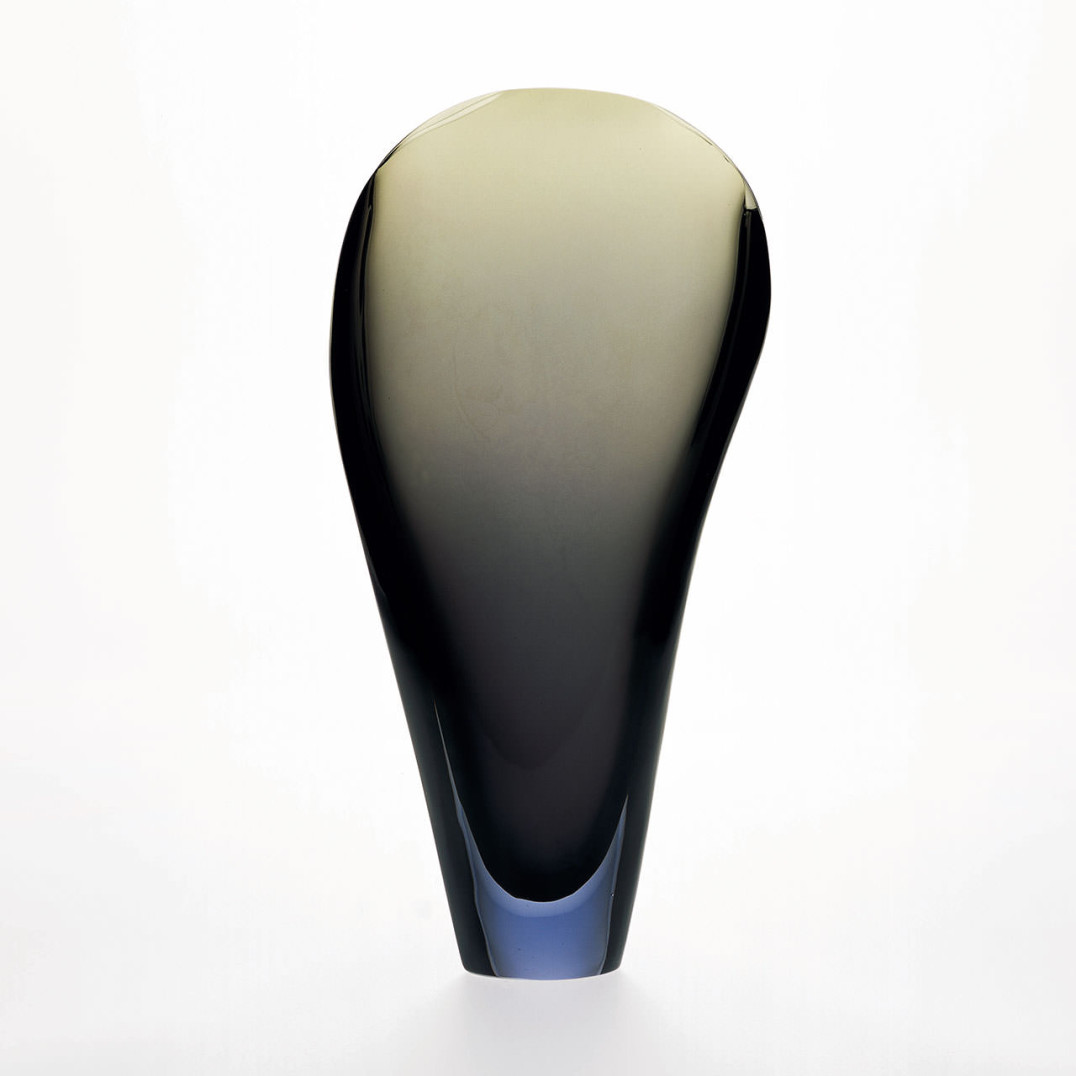
Flavio PoliValva, 1954
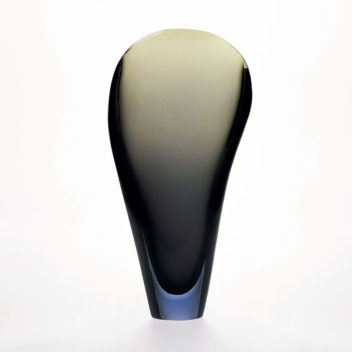
Flavio PoliValvaSeguso Vetri d'Arte, 1954
A sculptural vase shaped like a clam shell; composed of transparent grey sommerso in cristallo glass.
17 7/8 in high (45.5 cm)
Exhibitions:
1954, Venice, 27th Biennale Internazionale d’Arte;
2000, New York, Venetian Glass, Museum of Arts & Design;
2001, Milan, Murano: Vetri dalla Collezione Olnick Spanu, Spazio Oberdan.
Bibliography and comparative texts:
Domus, September, 1954;
R. Aloi, 1955, p.2;
G. Mariacher, 1967, p. 141;
R. Barovier Mentasti, 1977, n. 136;
Mille anni…, 1982, n. 639;
Die funfziger…, 1984, n. 10;
W. Neuwirth, 1987, n. 223;
La verrerie…, 1988, nn. 1, 6;
M. Heiremans, 1989, n. 113;
M. Karasik, 1989, n. 45;
M. Barovier, R. Barovier Mentasti,
A. Dorigato, 1995, n. 112;
M. Heiremans, 1996, n. 120;
H. Ricke, E. Schmitt, 1996, n. 13;
M. Barovier, 1999, p. 209;
Olnick Spanu, 2000, n. 112;
Olnick Spanu, 2001, n. 151.
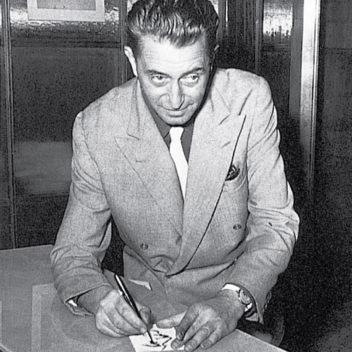
Flavio Poli 1900–1984
A designer, businessman, and ceramic artist, Flavio Poli was born in Chioggia. He attended the Istituto d'Arte di Venezia and began work as a designer in ceramics. In 1929 he switched to glass and designed animals, splendid Novecento-style nude figures in massiccio glass, as well as bowls and urns with figures resting on the inside, on lids or as handles for Libero Vitali's I.V.A.M. He subsequently collaborated with the Compagnia di Venezia e Murano, with the furnace of Mario and Lino Nason, and with the engraver Gino Francesconi. In 1934, he accepted the artistic direction of Barovier, Seguso & Ferro, later to become Seguso Vetri d'Arte, and became partner three years later. Together with Archimede Seguso, maestro of the principal team, Poli authored grandiose lighting installations, corroded vessels, sculptures in bulicante glass, and animals in massiccio glass. These productions represented a milestone in the development of the glassworks of Murano. At the height of his artistic maturity, in the years between 1950 and 1960, he designed a series of sommerso glass pieces in a Nordic style—essential forms and sharp cold colors—which were awarded prestigious prizes (Compasso d'Oro). He left Seguso in 1963 and between 1964 and 1966, he organized the artistic glass division at the Società Veneziana di Conterie e Cristallerie.
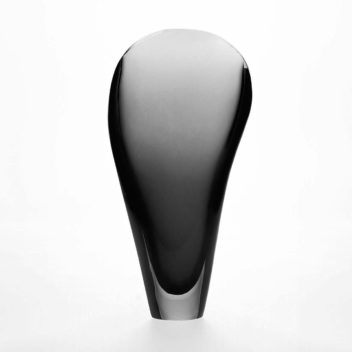
Seguso Vetri d'Arte 1937–1972
In 1933, several maestri who had left Vetreria Artistica Barovier, together with Archimede, Ernesto, and Alberto Seguso, founded the Vetreria e Soffieria Barovier Seguso & Ferro. Muranese painter Vittorio Zecchin took on the art direction for a short time with Flavio Poli replacing him in 1934. The company was reorganized in 1937 to become Seguso Vetri d'Arte. At this time, Poli also became a partner, and with the assistance of the maestro Archimede Seguso, they created animals and sculptures in thick glass, which were widely acclaimed at the Biennali of that period. After a new company reorganization in the '50s and '60s, the glasshouse produced a remarkable series of sommersi pieces, as well as the Valve and the unique Siderali pieces. The latter were designed by Poli, who remained in the company until 1963. After he left, Mario Pinzoni took over the artistic direction and remained stylistically faithful to his predecessor. Since the early '60s, the company has been directed by Maurizio Albarelli.
Flavio PoliValva, 1954
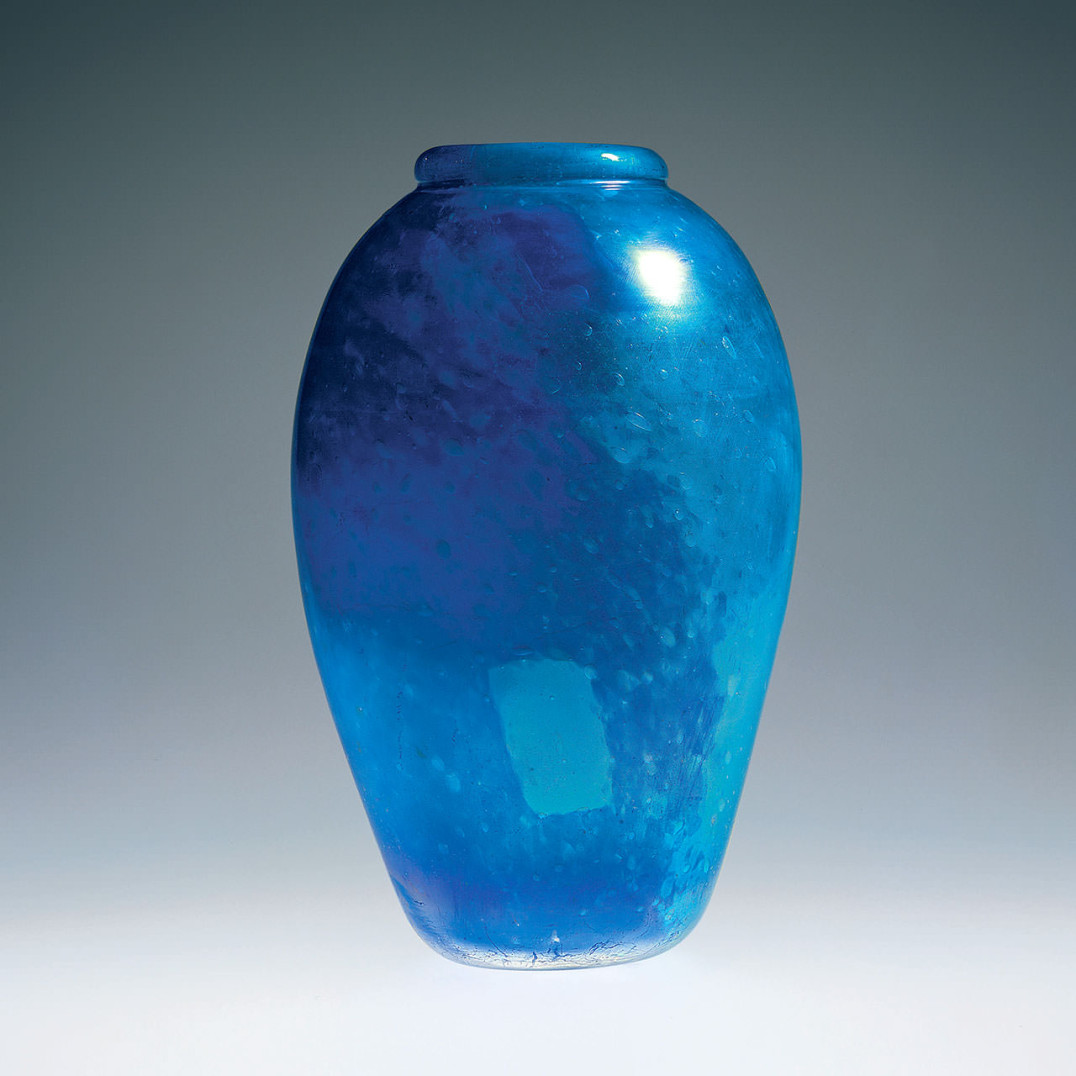
Dino MartensA macie, ca. 1950
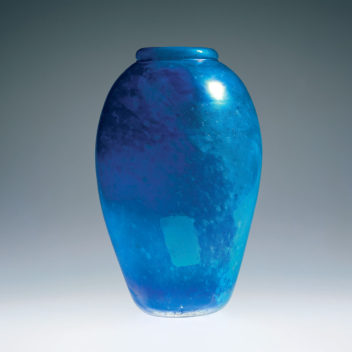
Dino MartensA macieAureliano Toso Vetri Decorativi, ca. 1950
Vase in clear trasparente glass
with inclusions of blue glass grit.
13 in. high (33 cm)
Exhibitions:
2001, Milan, Murano: Vetri dalla Collezione Olnick Spanu, Spazio Oberdan.
Bibliography and comparative texts:
M. Heiremans, 1993, n. 153;
M. Heiremans, 1996, n. 77;
M. Heiremans, 1999, nn. 16, 18;
Olnick Spanu, 2001, n. 150.
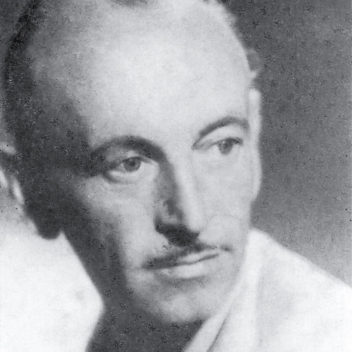
Dino Martens 1894–1970
Painter and designer Dino Martens was born in Venice, where he attended the Accademia di Belle Arti. In the mid '20s he moved to Murano, where for a short time he was a partner and decorator for the glass factory S.A.L.I.R. Later he worked as a designer for Salviati & C. and its successor Andrea Rioda. His Novecento-style paintings were exhibited at the Biennale di Venezia between 1924 and 1930. Upon his return from the African War in 1939, he became artistic director of the glass factory Aureliano Toso. From 1946 to 1960, Martens designed an incredible series of works for Toso. Using traditional Venetian techniques, he was able to obtain strikingly original multicolored effects combined with particularly daring asymmetric shapes. They included the compositions of glass rods called zanfirici; colorful pieces composed with irregular shadings, and inserts of avventurina and rods of filigrana called Oriente; as well as the unusual shapes of the Sommersi with battuto finish and the inside cased with multicolored glass. His collaboration with the Aureliano Toso ended in 1963.
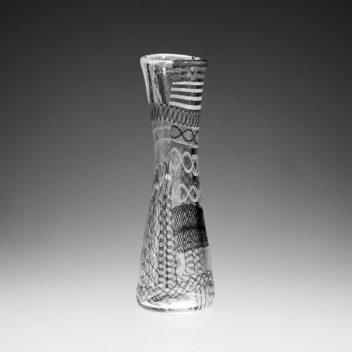
Aureliano Toso Vetri Decorativi 1932–
Founded in 1938 by Aureliano Toso, Aureliano Toso Vetri Decorativi boasted the artistic direction of Dino Martens, a painter from Murano, who worked with the company until 1965. The works created by Martens brought widespread acclaim at the major exhibitions of decorative arts, the colors being of particular interest. In 1962, the company sought the collaboration of outside consultants like Enrico Potz. After 1966, the artistic direction was entrusted to Gino Poli, who designed, among others, the collection A Solchi Colorati. Later, the company turned to the production of glass parts for lighting, which it still produces today.
Dino MartensA macie, ca. 1950
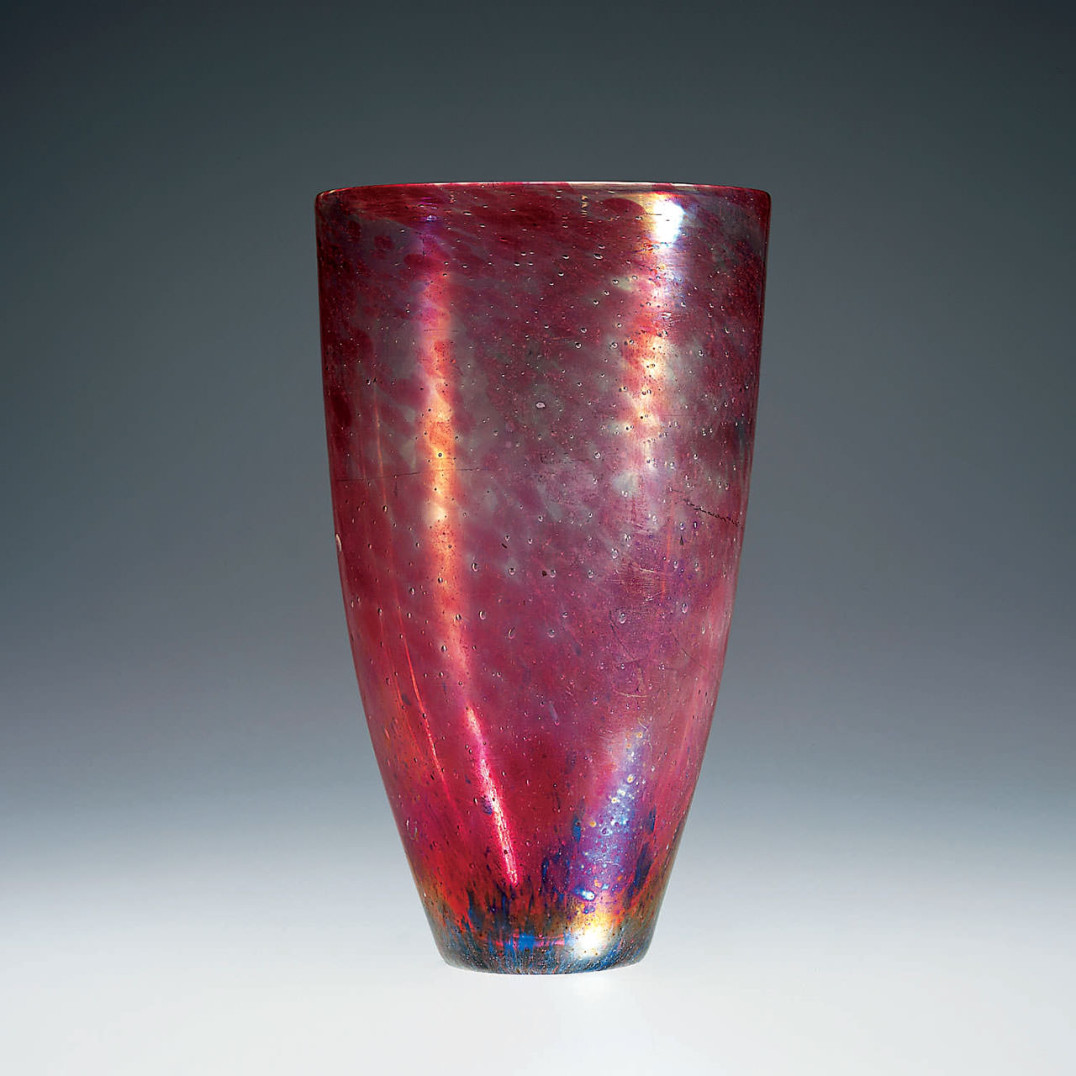
Dino MartensA macie, ca. 1950
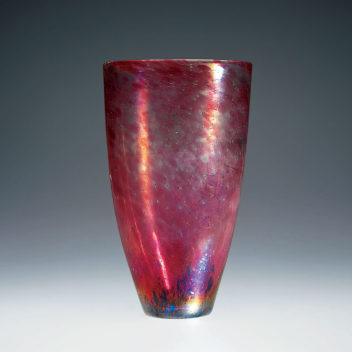
Dino MartensA macieAureliano Toso Vetri Decorativi, ca. 1950
Vase in clear trasparente glass with inclusions of ruby glass grit.
11 7/16 in. high (29 cm)
Exhibitions:
2001, Milan, Murano: Vetri dalla Collezione Olnick Spanu, Spazio Oberdan.
Bibliography and comparative texts:
M. Heiremans, 1993, n. 153;
M. Heiremans, 1996, n. 77;
M. Heiremans, 1999, nn. 16, 18;
Olnick Spanu, 2001, n. 149.

Dino Martens 1894–1970
Painter and designer Dino Martens was born in Venice, where he attended the Accademia di Belle Arti. In the mid '20s he moved to Murano, where for a short time he was a partner and decorator for the glass factory S.A.L.I.R. Later he worked as a designer for Salviati & C. and its successor Andrea Rioda. His Novecento-style paintings were exhibited at the Biennale di Venezia between 1924 and 1930. Upon his return from the African War in 1939, he became artistic director of the glass factory Aureliano Toso. From 1946 to 1960, Martens designed an incredible series of works for Toso. Using traditional Venetian techniques, he was able to obtain strikingly original multicolored effects combined with particularly daring asymmetric shapes. They included the compositions of glass rods called zanfirici; colorful pieces composed with irregular shadings, and inserts of avventurina and rods of filigrana called Oriente; as well as the unusual shapes of the Sommersi with battuto finish and the inside cased with multicolored glass. His collaboration with the Aureliano Toso ended in 1963.

Aureliano Toso Vetri Decorativi 1932–
Founded in 1938 by Aureliano Toso, Aureliano Toso Vetri Decorativi boasted the artistic direction of Dino Martens, a painter from Murano, who worked with the company until 1965. The works created by Martens brought widespread acclaim at the major exhibitions of decorative arts, the colors being of particular interest. In 1962, the company sought the collaboration of outside consultants like Enrico Potz. After 1966, the artistic direction was entrusted to Gino Poli, who designed, among others, the collection A Solchi Colorati. Later, the company turned to the production of glass parts for lighting, which it still produces today.
Dino MartensA macie, ca. 1950
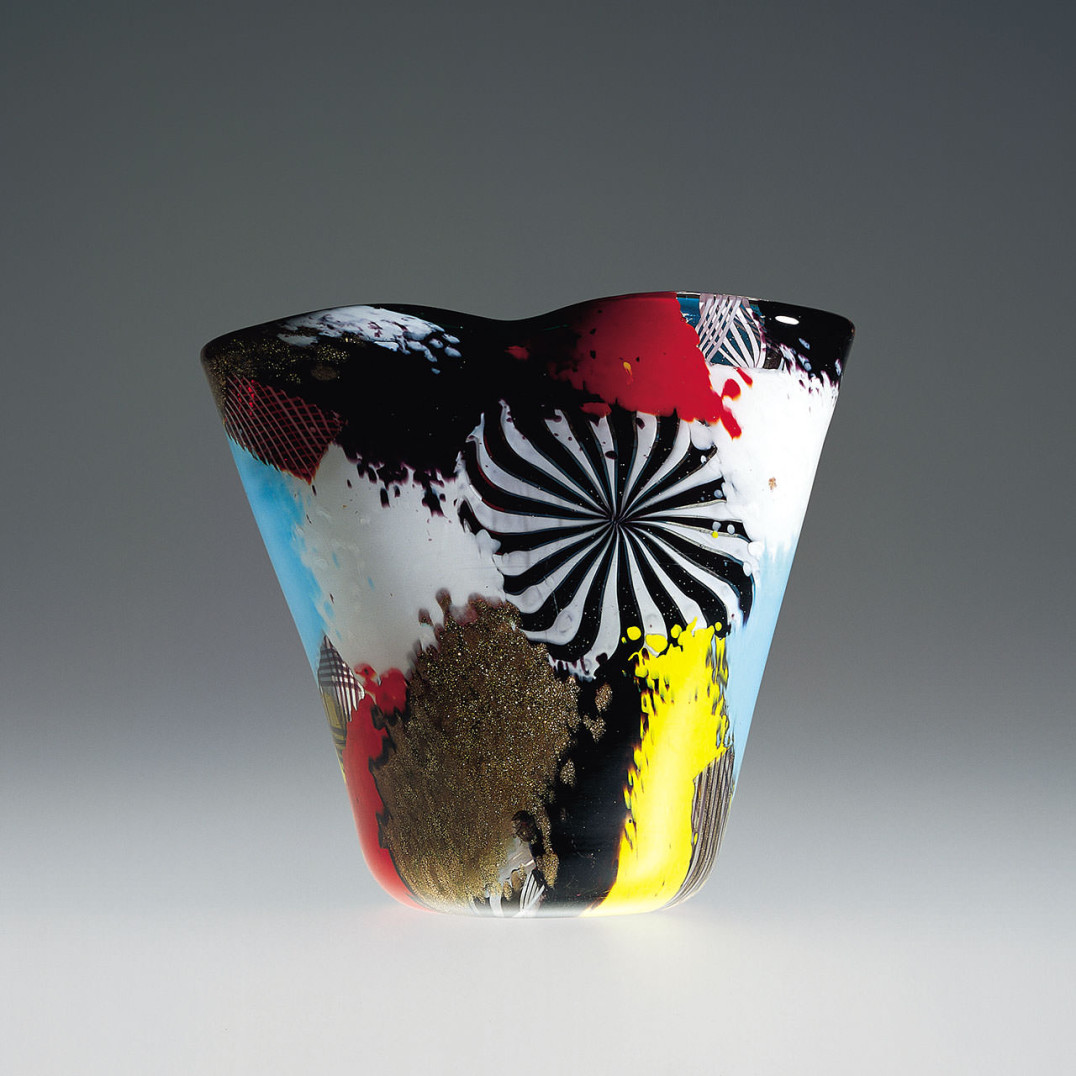
Dino MartensOriente, 1952
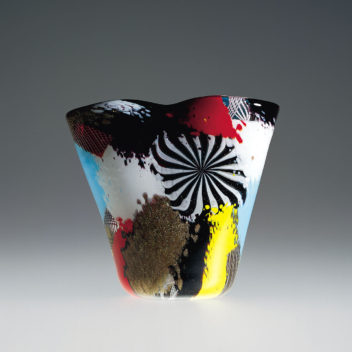
Dino MartensOrienteAureliano Toso Vetri Decorativi, 1952
Vessel from the Oriente series. This model is also known as Nabucco. Made with irregular patches of multicolored glass, inclusions of avventurina and canes of zanfirico and reticello.
This vessel
conforms with model n. 3121 of
the manufacturer’s catalogue.
8 1/4 in. high (21 cm)
Exhibitions:
1952, Venice, 26th Biennale Internazionale d’Arte;
2000, New York, Venetian Glass, Museum of Arts & Design;
2001, Milan, Murano: Vetri dalla Collezione Olnick Spanu, Spazio Oberdan.
Bibliography and comparative texts:
Mille anni…, 1982, n. 615;
Intérieurs ’50, 1983, n. 137;
W. Neuwirth, 1987, n. 95;
M. Heiremans, 1989, n. 136;
R. Barovier Mentasti, 1992, n. 104;
M. Heiremans, 1993, nn. 155, 157, 161, 162;
M. Barovier, 1994, nn. 27-29;
Venezia e la Biennale…, 1995, n. 486;
F. Deboni, 1996, nn. 152, 153;
M. Heiremans, 1996, nn. 122-124;
H. Ricke, E. Schmitt, 1996, nn. 203-206;
L. M. Barbero, 1997, p. 231;
M. Barovier, 1999, p. 217;
M. Heiremans, 1999, n. 57b;
Olnick Spanu, 2000, n. 110-111;
Olnick Spanu, 2001, n. 148.

Dino Martens 1894–1970
Painter and designer Dino Martens was born in Venice, where he attended the Accademia di Belle Arti. In the mid '20s he moved to Murano, where for a short time he was a partner and decorator for the glass factory S.A.L.I.R. Later he worked as a designer for Salviati & C. and its successor Andrea Rioda. His Novecento-style paintings were exhibited at the Biennale di Venezia between 1924 and 1930. Upon his return from the African War in 1939, he became artistic director of the glass factory Aureliano Toso. From 1946 to 1960, Martens designed an incredible series of works for Toso. Using traditional Venetian techniques, he was able to obtain strikingly original multicolored effects combined with particularly daring asymmetric shapes. They included the compositions of glass rods called zanfirici; colorful pieces composed with irregular shadings, and inserts of avventurina and rods of filigrana called Oriente; as well as the unusual shapes of the Sommersi with battuto finish and the inside cased with multicolored glass. His collaboration with the Aureliano Toso ended in 1963.

Aureliano Toso Vetri Decorativi 1932–
Founded in 1938 by Aureliano Toso, Aureliano Toso Vetri Decorativi boasted the artistic direction of Dino Martens, a painter from Murano, who worked with the company until 1965. The works created by Martens brought widespread acclaim at the major exhibitions of decorative arts, the colors being of particular interest. In 1962, the company sought the collaboration of outside consultants like Enrico Potz. After 1966, the artistic direction was entrusted to Gino Poli, who designed, among others, the collection A Solchi Colorati. Later, the company turned to the production of glass parts for lighting, which it still produces today.
Dino MartensOriente, 1952
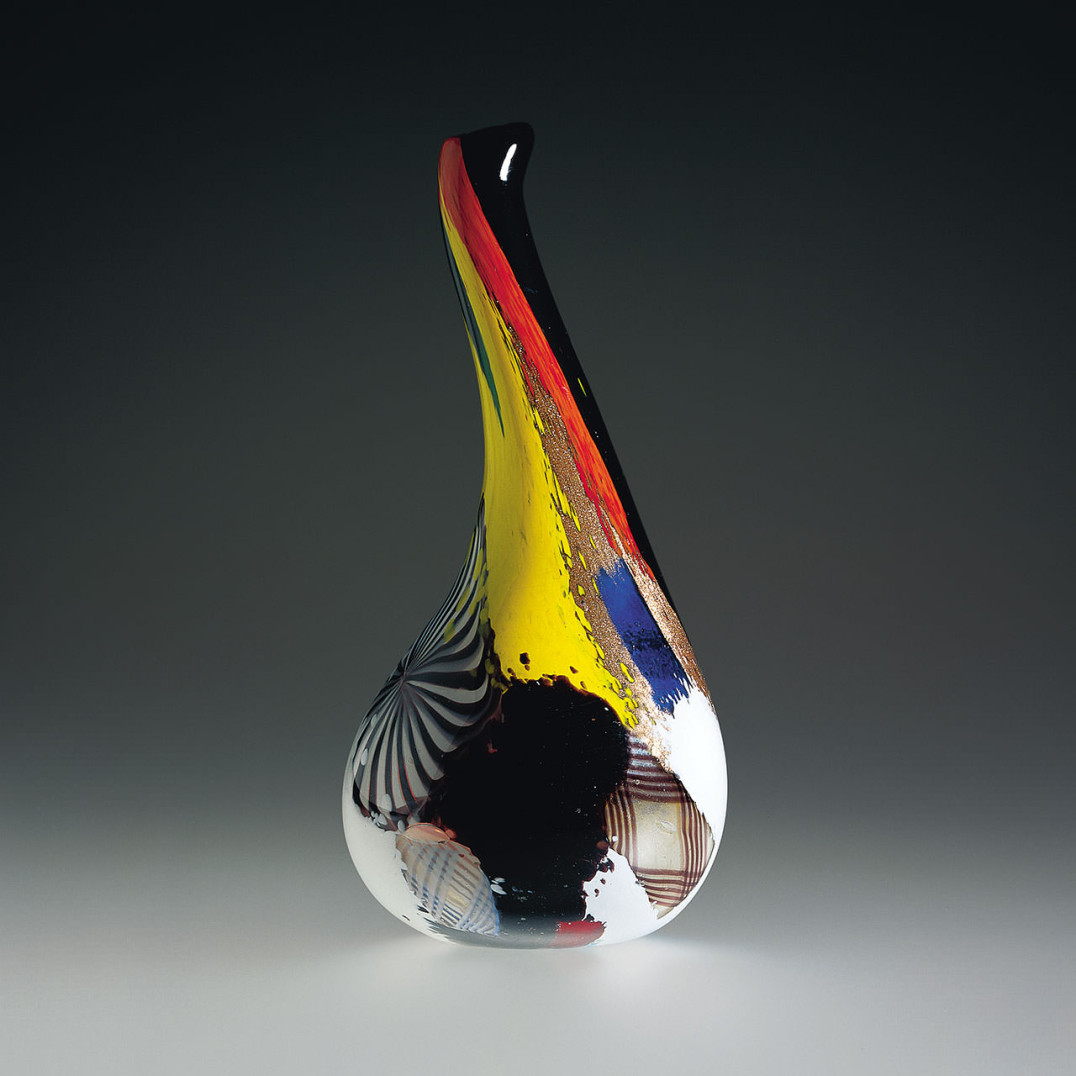
Dino MartensOriente, 1952
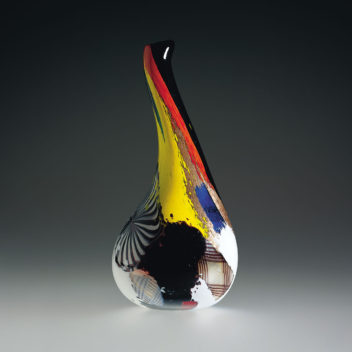
Dino MartensOrienteAureliano Toso Vetri Decorativi, 1952
Vessel from the Oriente series. This model, also known as Olaf, made with irregular patches of multicolored glass, inclusions of avventurina and canes of zanfirico and reticello.
Vessel conforms with model n. 3122 of the manufacturer’s catalogue.
14 in. high (35.5 cm)
Exhibitions:
1952, Venice, 26th Biennale Internazionale d’Arte;
2000, New York, Venetian Glass, Museum of Arts & Design;
2001, Milan, Murano: Vetri dalla Collezione Olnick Spanu, Spazio Oberdan.
Bibliography and comparative texts:
Mille anni…, 1982, n. 615;
Intérieurs ’50, 1983, n. 137;
W. Neuwirth, 1987, n. 95;
M. Heiremans, 1989, n. 136;
R. Barovier Mentasti, 1992, n. 104;
M. Heiremans, 1993, nn. 155, 157, 161, 162;
M. Barovier, 1994, nn. 27–29;
Venezia e la Biennale…, 1995, n. 486;
F. Deboni, 1996, nn. 152, 153.
M. Heiremans, 1996, nn. 122-124;
H. Ricke, E. Schmitt, 1996, nn. 203-206;
L.M. Barbero, 1997, p. 231;
M. Barovier, 1999, p. 217;
M. Heiremans, 1999, n. 43;
Olnick Spanu, 2000, n. 110-111;
R. Reif, New York Times, 2000, p. 39;
Olnick Spanu, 2001, n. 147.

Dino Martens 1894–1970
Painter and designer Dino Martens was born in Venice, where he attended the Accademia di Belle Arti. In the mid '20s he moved to Murano, where for a short time he was a partner and decorator for the glass factory S.A.L.I.R. Later he worked as a designer for Salviati & C. and its successor Andrea Rioda. His Novecento-style paintings were exhibited at the Biennale di Venezia between 1924 and 1930. Upon his return from the African War in 1939, he became artistic director of the glass factory Aureliano Toso. From 1946 to 1960, Martens designed an incredible series of works for Toso. Using traditional Venetian techniques, he was able to obtain strikingly original multicolored effects combined with particularly daring asymmetric shapes. They included the compositions of glass rods called zanfirici; colorful pieces composed with irregular shadings, and inserts of avventurina and rods of filigrana called Oriente; as well as the unusual shapes of the Sommersi with battuto finish and the inside cased with multicolored glass. His collaboration with the Aureliano Toso ended in 1963.

Aureliano Toso Vetri Decorativi 1932–
Founded in 1938 by Aureliano Toso, Aureliano Toso Vetri Decorativi boasted the artistic direction of Dino Martens, a painter from Murano, who worked with the company until 1965. The works created by Martens brought widespread acclaim at the major exhibitions of decorative arts, the colors being of particular interest. In 1962, the company sought the collaboration of outside consultants like Enrico Potz. After 1966, the artistic direction was entrusted to Gino Poli, who designed, among others, the collection A Solchi Colorati. Later, the company turned to the production of glass parts for lighting, which it still produces today.